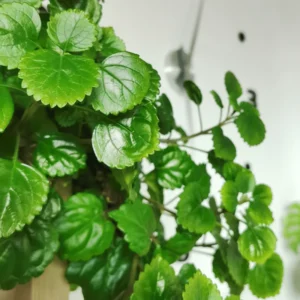Growing Swedish Ivy Plant
Swedish Ivy, or Plectranthus verticillatus, is a plant that radiates vitality and green opulence. Thriving in the cozy corners of homes and heartily cascading over the edges of pots, it’s a botanical spectacle that invites admiration.
In this guide, we’ll dive deep into everything you need to know about Swedish Ivy, from its unique background and benefits to detailed care instructions, troubleshooting tips, and decor ideas. Whether you’re a beginner or a seasoned gardener, Swedish Ivy can be a wonderful addition to your indoor garden.
Understanding Swedish Ivy

Swedish Ivy, despite its name, is neither Swedish nor a true ivy. Native to South Africa and Australia, it is named for its ivy-like appearance and its popularity in Scandinavian homes. This plant, which belongs to the mint family (Lamiaceae), has shiny, scalloped-edged leaves that grow quickly, creating a full, bushy appearance. During warmer months, you may even spot tiny white or light purple flowers, adding a delicate touch to its vibrant foliage.
The plant’s adaptability and low maintenance make it ideal for busy households and various interior styles, from minimalist to Scandinavian decor. Understanding its origins and unique characteristics can enhance your appreciation for this plant and help you create an environment where it will thrive.
Optimal Growing Conditions
To keep Swedish Ivy thriving, it’s essential to create an environment that mimics its native habitat:
- Light Requirements: Swedish Ivy prefers bright, indirect light. Place it near a window with filtered sunlight; direct sunlight can scorch the leaves, while low light may result in leggy growth. A spot with indirect sunlight from an east- or west-facing window is ideal.
- Temperature Needs: The ideal temperature range for Swedish Ivy is 60-75°F (15-24°C). It can tolerate occasional drops in temperature but should be kept away from drafts or extreme cold. For optimal growth, avoid placing it near heating or cooling vents.
- Humidity Preferences: Swedish Ivy enjoys humidity, making it a great plant for bathrooms or kitchens where moisture levels are naturally higher. However, it’s adaptable to average indoor humidity levels as long as it’s not exposed to extremely dry conditions.
- Soil Recommendations: A well-draining potting mix is essential to prevent root rot. Combine peat moss, perlite, and vermiculite to create a lightweight, well-aerated soil mix that retains moisture without becoming waterlogged. Avoid heavy garden soil, as it can compact and restrict root growth.
Planting and Propagation

Swedish Ivy is easy to propagate, allowing you to grow plants from cuttings:
- Take a Cutting: Choose a healthy, vibrant stem and cut a 4-6 inch segment just below a leaf node. This is where new roots will develop.
- Prepare the Cutting: Remove the lower leaves from the cutting, leaving a few leaves at the top. This helps prevent rotting and promotes root growth.
- Rooting in Water or Soil: Place the cutting in a glass of water or plant it directly into moist soil. If you’re using water, make sure to change it every few days to keep it fresh. In 2-3 weeks, roots should start forming.
- Transplanting: Once roots are well-established (about 1-2 inches long), transplant the cutting into a pot with well-draining soil. Water it lightly to help it settle into its new environment.
Routine Care and Maintenance
- Watering: Consistency is key. Allow the top inch of soil to dry out between waterings. Overwatering is the nemesis of Swedish Ivy, leading to soggy roots and a disheartened plant.
- Feeding: During the growing season, a balanced, water-soluble fertilizer monthly will suffice. This nourishment supports its rapid growth, keeping the foliage dense and vibrant.
- Pruning: Regular pruning not only maintains aesthetics but encourages a bushier, more robust plant. Don’t shy away from trimming leggy stems, as this invigorates new growth.
Troubleshooting Common Problems
Even easy-care plants like Swedish Ivy can face occasional challenges. Here’s how to handle the most common issues:
- Pests: Swedish Ivy may attract pests such as spider mites and mealybugs. Regularly inspect the plant for any signs of infestation, such as white or yellow specks on the leaves. Use a gentle insecticidal soap or neem oil to treat infestations.
- Yellowing Leaves: Yellow leaves often indicate overwatering. Check the soil moisture, and if it’s too wet, allow the soil to dry out before the next watering.
- Drooping Leaves: Drooping can be a sign of underwatering. Ensure the soil is moist but not soaked, and adjust your watering schedule as needed.
- Root Rot: This is a common issue with overwatered Swedish Ivy. If you notice blackened or mushy roots, trim them away and repot the plant in fresh, well-draining soil.
Styling and Usage in Home Decor
Swedish Ivy’s trailing vines make it an ideal choice for hanging baskets, where it can cascade down naturally, creating a lush, green display. Alternatively, place it on high shelves or ledges to allow the vines to drape elegantly. This plant’s adaptability to different light conditions and easy care requirements make it a great addition to home decor, whether for experienced plant enthusiasts or beginners.
- Hanging Baskets: Hang Swedish Ivy in baskets for a beautiful, natural curtain of greenery. This is an ideal way to let its vines drape freely.
- Bookshelves or High Ledges: Swedish Ivy’s trailing growth works wonderfully on bookshelves or high ledges, adding greenery without taking up floor space.
- Grouping with Other Plants: Swedish Ivy pairs well with other low-maintenance indoor plants. Combine it with succulents, ferns, or other trailing plants to create an indoor garden look.
- Terrariums: For a unique approach, Swedish Ivy can be grown in large, open terrariums where it adds texture and interest alongside other small plants.
FAQs: Common Questions About Swedish Ivy
1. How often should I water Swedish Ivy?
Water Swedish Ivy when the top inch of soil feels dry. Avoid overwatering to prevent root rot.
2. Why are the leaves on my Swedish Ivy turning yellow?
Yellowing leaves usually indicate overwatering. Let the soil dry out and reduce the frequency of watering.
3. Can Swedish Ivy grow outdoors?
Yes, Swedish Ivy can be grown outdoors in shaded, frost-free areas. Bring it inside if temperatures drop below 60°F (15°C).
4. How fast does Swedish Ivy grow?
Swedish Ivy grows relatively quickly, especially in bright, indirect light. Regular pruning helps it stay compact and encourages dense growth.
5. What is the best way to display Swedish Ivy?
Swedish Ivy is ideal for hanging baskets, high shelves, or ledges where its vines can cascade down naturally.
Conclusion
Swedish Ivy is a versatile, easy-care plant that enhances any indoor space with its lush green vines and effortless beauty. Its air-purifying qualities, fast growth, and low maintenance make it ideal for both beginners and experienced plant lovers. By following the care tips in this guide, you can enjoy a thriving Swedish Ivy that transforms your home into a green, serene retreat. Embrace the joy of growing Swedish Ivy, and let its leafy, cascading charm bring life to your decor.
